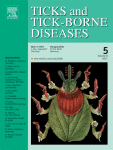Ver ítem
- xmlui.general.dspace_homeCentros e Institutos de InvestigaciónCICVyA. Centro de Investigación en Ciencias Veterinarias y AgronómicasInstituto de PatobiologíaArtículos científicosxmlui.ArtifactBrowser.ItemViewer.trail
- Inicio
- Centros e Institutos de Investigación
- CICVyA. Centro de Investigación en Ciencias Veterinarias y Agronómicas
- Instituto de Patobiología
- Artículos científicos
- Ver ítem
Characterization of a papain-like cysteine protease essential for the survival of Babesia ovis merozoites
Resumen
Babesia ovis, a tick-transmitted intraerythrocytic protozoan parasite, causes severe infections in small ruminants from Southern Europe, Middle East, and Northern Africa. With the aim of finding potential targets for the development of control methods against this parasite, sequence analysis of its genome led to
the identification of four putative cysteine proteases of the C1A family. Orthology between B. ovis, B. bovis, T. annulata, and T. parva
[ver mas...]
Babesia ovis, a tick-transmitted intraerythrocytic protozoan parasite, causes severe infections in small ruminants from Southern Europe, Middle East, and Northern Africa. With the aim of finding potential targets for the development of control methods against this parasite, sequence analysis of its genome led to
the identification of four putative cysteine proteases of the C1A family. Orthology between B. ovis, B. bovis, T. annulata, and T. parva sequences showed that each B. ovis C1A peptidase sequence clustered within one of the four ortholog groups previously reported for these piroplasmids. The ortholog of bovipain-2 of B. bovis and falcipain-2 of Plasmodium falciparum, respectively, was designated “ovipain-2” and further characterized. In silico analysis showed that ovipain-2 has the typical topology of papain-like cysteine peptidases and a highly similar predicted three dimensional structure to bovipain-2 and falcipain-2, suggesting susceptibility to similar inhibitors. Immunoblotting using antibodies raised against a recombinant form of ovipain-2 (r-ovipain-2) demonstrated expression of ovipain-2 in in vitro cultured B. ovis merozoites.
By immunofluorescence, these antibodies reacted with merozoites and stained the cytoplasm of infected erythrocytes. This suggests that ovipain-2 is secreted by the parasite and could be involved in intra- and extracellular digestion of hemoglobin and/or cleavage of erythrocyte proteins facilitating parasite egress. A significant reduction in the percentage of parasitized erythrocytes was obtained upon incubation of B. ovis in vitro cultures with anti-r-ovipain-2 antibodies, indicating an important functional role for ovipain-2 in the intra erythrocytic development cycle of this parasite. Finally, studies of the reactivity of sera from B. ovis-positive and negative sheep against r-ovipain-2 showed that this protease is expressed in vivo, and can be recognized by host antibodies. The results of this study suggest that ovipain-2 constitutes a potential target for immunotherapies and drug development against ovine babesiosis.
[Cerrar]

Autor
Carletti, Tamara;
Mesplet, Maria;
Mira, Anabela;
Weir, William;
Shiels, Brian;
Gonzalez Oliva, Abel;
Schnittger, Leonhard;
Florin-Christensen, Mónica;
Barreto, Carmo;
Fuente
Ticks and tick-borne diseases 7 (1) : 85-93. (February 2016)
Fecha
2016
ISSN
1877-959X
Formato
pdf
Tipo de documento
article
Palabras Claves
Derechos de acceso
Restringido
 Excepto donde se diga explicitamente, este item se publica bajo la siguiente descripción: Creative Commons Attribution-NonCommercial-ShareAlike 2.5 Unported (CC BY-NC-SA 2.5)
Excepto donde se diga explicitamente, este item se publica bajo la siguiente descripción: Creative Commons Attribution-NonCommercial-ShareAlike 2.5 Unported (CC BY-NC-SA 2.5)

